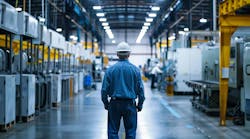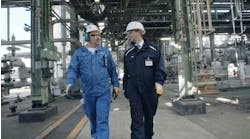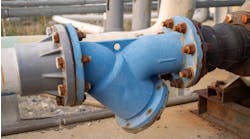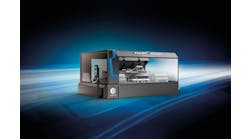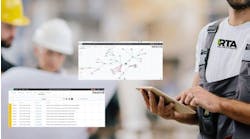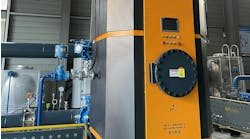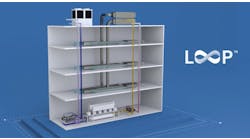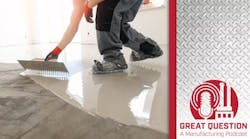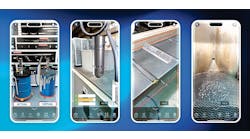Industrial manufacturing, warehouse, and distribution centers can have hundreds of thousands of square feet of production and storage space that is prone to dangerous slips, trips, and falls. The risk is heightened when surfaces are wet from cleaning, spills are present, and personnel is busy with work tasks. Cold storage can be slippery due to condensation or ice melt. Other areas can be also susceptible to slip and fall risk when subject to wet weather outdoors.
According to The National Institute for Occupational Safety and Health (NIOSH)’s Traumatic Occupational Injuries Fast Facts webpage, the “most recent traumatic injury data show [that] 27% of the 888,220 nonfatal work injuries resulting in days away from work in 2019 were related to slips, trips, and falls.”
Slips result from a loss of balance caused by too little friction between people’s feet and the surface they walk or work on. Loss of traction is the leading cause of workplace slips. Although conventional non-slip coatings have been used to improve traction, these tend to wear quickly and need to be reapplied often at considerable expense.
Fortunately, a new category of durable, high-tech, all-epoxy coating is dramatically increasing traction and improving safety in a wide range of slip and fall-prone areas such as production floors, warehouse space, loading docks, platforms, ramps, walkways, emergency staircases, stair landings, and ladders. Beyond this, due to the extra traction the non-slip coating provides, it is not only being used to improve personnel footing on truck trailers but also to stabilize the heavy trailer loads.
This new type of coating is designed to last years even in areas heavily traveled on foot, which reduces the need for maintenance and replacement. The coating type can be quickly and easily applied by facility personnel, minimizing cost and facility disruption.
Problematic Short-Term, Non-Skid Coatings
Improving the traction of workplace walking surfaces to increase safety is not a new concept. However, traditional options quickly become compromised in industrial settings.
When companies apply conventional non-skid coatings to these surfaces, aggregate is usually mixed in or sprinkled on top in an attempt to embed it in the coating to enhance traction. The challenge is that the aggregate quickly pulls loose from most coatings, impairing traction, for a couple of reasons.
When aggregate is mixed into the coating, a problem emerges with low viscosity, non-skid products.
“The coating thickness has to be substantial enough to hold the aggregate, the non-slip material, in suspension. However, most conventional coatings cannot keep the aggregate in suspension. With low-viscosity coatings containing a low percentage of epoxy, the aggregate falls to the bottom of the bucket during mixing, so you are essentially forced to apply it on top,” says Bob Finkenaur, owner of a Veteran Owned Small Business, who has years of experience providing high-value formulated products and solutions to a wide variety of professional and consumer markets.
“Most conventional non-skid coatings also shrink considerably after application due to water or solvent evaporation. Often, when the coating dries or cures, its thickness is only about half [the thickness] of when it was wet. The relative thinness of the coating is another reason that any embedded aggregate is prone to fall out, reducing traction,” he adds.
Consequently, a new coating with additional aggregate must be reapplied frequently, and internal safety standards may only be met only a fraction of the desired time.
Long-Term Prevention of Industrial Slips and Falls
As a solution, to improve traction and prevent slips and falls for the long-term in various industrial settings, innovators have developed a new category of extremely durable, all epoxy coatings designed to embed aggregate in the coating for years. The approach facilitates meeting internal safety standards and virtually eliminates the need for non-skid coating reapplication, reducing maintenance costs.
For example, the non-skid coating Form-A-Tread SL (Self Leveling) by Form-A-Tread Company is a combination of a low-to-medium viscosity epoxy binder consisting of 100% solids and a specialized aggregate broadcast on top. The coating can be used in a variety of manufacturing or storage environments on concrete, asphalt, metal diamond plate, wood, and other porous and non-porous substrates. The formulation along with its topically applied aggregate is designed for indoor and outdoor use and can last for years even when exposed to sunlight, chemicals, weather, and temperature extremes.
The patented coating provides a very durable, slip-resistant surface on industrial flooring, walkways, ramps, and other large areas with high pedestrian or vehicle traffic. The coating is easy to mix and apply by hand. Installation is fast and the surface is typically ready for use within hours. The coating has already been utilized by some giants of the industry.
In the case of Consolidated Edison, Inc., one of the nation’s largest investor-owned energy-delivery companies, the company’s EH&S team proactively sought to reduce the risk of slip and fall incidents across multiple locations, as well as address an issue with shifting cargo loads while transporting equipment and supplies.
According to Richard Stewart, a Con Edison EH&S manager supporting Shared Services organizations, Con Edison has used the Form-A-Tread SL coating on a wide variety of surfaces and applications. This has included many high-traffic areas such as a receiving warehouse in Astoria; stairways in the Bronx; walkway ramps and dock loading ramps in Staten Island; and even plastic bumpers on utility vans that can become quite slick when wet.
The innovative use to secure tractor-trailer loads would also win the team that worked on this initiative a Con Edison 2021 Con Edison EH&S Team Award. This recognized the team’s extraordinary contribution to ensuring a safe workplace, achieving operational excellence, and improving how tractor-trailer loads are secured.
“When we got feedback from all the groups involved, they were impressed how the coating solved two issues at once,” says Stewart. “The drivers loved it because even on rainy, windy days the coating improved safety by providing sufficient traction and footing [on the aluminum trailer beds]. The improved traction also helped ensure large cargo would not shift on the trailer during transport.”
For his involvement with the project, Stewart was part of the team recognized in a Con Edison news article, and the project won Con Edison’s EH&S Sustainability Award.
He notes that as an EH&S Manager he often responds to issues with a solution or recommendation to help eliminate similar hazards across multiple locations.
“Working with a durable non-slip coating that can be applied to a variety of materials such as metal, concrete, asphalt, and wood, allows us to use the same solution to resolve many different issues,” concludes Stewart. “It is a very customizable product so wherever there is a need, we can use it. It gives us a lot of options.”
As industrial facilities seek to prevent slip and fall hazards across a greater range of workplace walking surfaces, implementing durable, non-skid, all epoxy coatings will effectively enhance safety in the long term. Since the option is designed to withstand high foot traffic in many settings, it will also significantly reduce maintenance and replacement costs.
